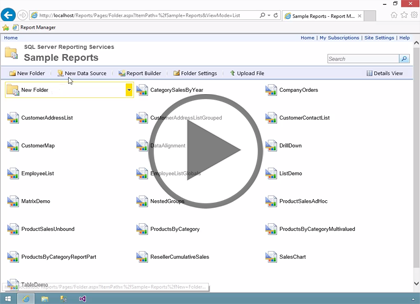Course description
In this course you’ll learn about reporting tools, starting with seeing how you can use Management Studio for some tasks. Management Studio is far more limited than Report Manager for report server management, but nonetheless supports some important tasks. You’ll learn the three primary kinds of tasks you’ll need to use Management Studio for, as well as how to access those features. Then you’ll explore the management features of Report Manager. You’re likely to use Management Studio occasionally for the tasks it supports, but use Report Manager every day to do things like manage files and folders, including reports, and change and manage site settings and folder and object settings.
Prerequisites
This course assumes that you have a basic familiarity with the concept of relational databases and a basic understanding of what SQL Server is and the high-level tools in it, as well as how to create and manage objects using Management Studio. You should also have a basic understanding of how SQL Server implements security, including its authentication and authorization schemes, and how to assign permissions on securable objects to principals. You should know the fundamentals of Transact-SQL to write queries to retrieve data and join data from multiple tables, and how to execute scripts using the query editor in Management Studio.
It will be very helpful, but not absolutely necessary, to have experience with .NET development using Visual Studio 2012 or 2013 for the portions of the course that deal with SQL Server Data Tools. At the very least, we’ll assume that you are well familiar with the Visual Studio user interface.
Learning Paths
This course will help you prepare for the following certifications and exams:
MCSE: Business Intelligence
70-467: Designing Business Intelligence Solutions with Microsoft SQL Server
70-466: Implementing Data Models and Reports with Microsoft SQL Server
This course is part of the following LearnNowOnline SuccessPaths™:
SQL Server Reporting Services
Meet the expert
Don Kiely is a featured instructor on many of our SQL Server and Visual Studio courses. He is a nationally recognized author, instructor, and consultant specializing in Microsoft technologies. Don has many years of teaching experience, is the author or co-author of several programming books, and has spoken at many industry conferences and user groups. In addition, Don is a consultant for a variety of companies that develop distributed applications for public and private organizations.
Course outline
Managing Reporting Services
Administration and Management (20:01)
- Introduction (00:41)
- SQL Server Management Studio (01:22)
- Demo: Connect to Server (04:58)
- Demo: Properties - general (05:01)
- Demo: Properties - execution (01:55)
- Demo: History Page (01:39)
- Demo: Logging (00:46)
- Demo: Security (03:08)
- Summary (00:26)
Security and SharedSchedules (13:31)
- Introduction (00:54)
- Demo: Jobs & Security (05:49)
- Demo: User Role (01:06)
- Demo: System Roles (01:47)
- Demo: Create New Roles (01:06)
- Demo: Shared Schedules (02:23)
- Summary (00:23)
Report Manager (13:53)
- Introduction (00:32)
- Report Manager (01:21)
- Demo: Report Manager (04:25)
- Demo: Managing Folders & Files (02:58)
- Demo: Reports & Data Sources (01:36)
- Demo: Site Settings (02:05)
- Summary (00:53)
Creating Linked Reports (15:54)
- Introduction (01:05)
- Creating Linked Reports (01:12)
- Demo: Linked Reports (04:32)
- Demo: Linking Europe (04:05)
- Demo: Linked Europe (04:11)
- Summary (00:46)



